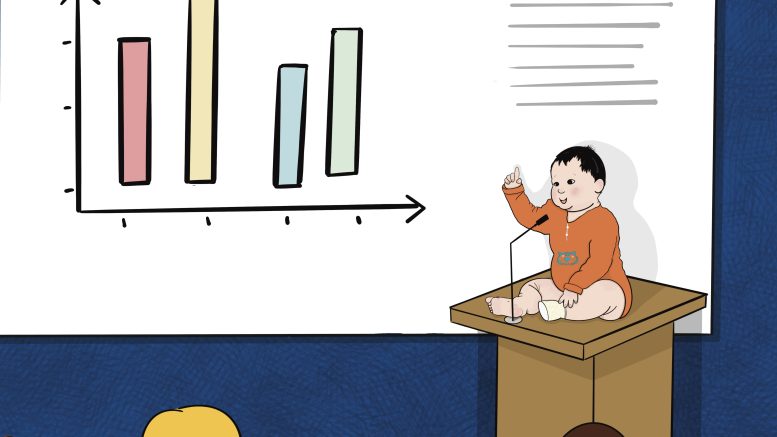Before babies are even born, they begin learning how to speak. In the uterus, they hear and respond to voices and start to understand how words, rhythm, sound and speed of speech work together as part of language. Once born, babies watch other people and learn to copy the facial and tongue movements that produce speech.
The development of language in babies is a research focus of Melanie Soderstrom, U of M psychology professor and director of the Baby Language Lab.
Soderstrom started her research journey in biology. As an undergraduate student, she was involved in a twin study that examined genetic precursors to language development. She quickly “fell in love” with the subject and switched tracks to psychology.
“I just think the early processes of language development in humans is really fascinating and impressive, and one of the most amazing features of our human development,” she said. “I love to study it.”
One focus of the Baby Language Lab is to study infant speech perception. This is done by playing a variety of speech sounds for babies. Researchers can better understand the process of early language development by evaluating babies’ preferences and ability to distinguish between different sounds.
The lab also looks at babies’ daily sound-filled environments. This is done by collecting audio recordings of their daily lives, analyzing the sounds they hear and understanding their responses.
“We’re trying to get a window into infants’ everyday real-world experiences,” Soderstrom said. “It’s one thing to understand this process from the perspective of what happens in a laboratory, but language development doesn’t happen in a laboratory, it happens in the real world.”
Over the last few years, much of Soderstrom’s work has been on infant-directed speech, more commonly known as baby talk. This speech tends to be high-pitched with a happy tone, using short utterances and a simple vocabulary.
Further exploring the nature of what babies hear, Soderstrom co-authored a paper titled “What Do North American Babies Hear? A large-scale cross-corpus analysis.” The study used a collection of day-long recordings of 61 homes from four cities in North America to analyze what babies hear on a daily basis.
The study found that babies heard two to three times more speech from women than men. Women used baby talk 11 per cent more frequently than men. This is expected, researchers explained, as there tend to be many caregivers in the early period of an infant’s life who are women. Because of the high amount of speech babies hear from women, the study theorized that babies tend to use phonemes, or sound units, that are characteristic of women.
Soderstrom emphasized the importance of language development. She said language, whether spoken or signed, is necessary for humans to flourish.
“Every human infant needs some sort of language to communicate with people around them,” Soderstrom said. “It’s really a fundamental process in our everyday experiences.”
Soderstrom highlighted that, even though there are still sometimes those who disparage baby talk, a vast body of research exists demonstrating its importance.
When babies hear baby talk, they often understand it is directed toward them and pay close attention to it. Baby talk, with its exaggerated pitches, melodic patterns and happy tone, is often easier for babies to listen to than regular speech.
Western Sydney University researcher Marina Kalashnikova encourages parents to use baby talk early in their infants’ lives in order to become comfortable using it.
Additionally, researchers at the University of Florida found that the sounds adults make when using baby talk imitate the vocalizations produced by a smaller vocal tract. Not only is baby talk enjoyable for babies to listen to, it could help them understand how to create speech themselves.
Ultimately, Soderstrom encourages mothers to engage their infants in baby talk, “whether it’s in a highly exaggerated form of infant-directed speech, or just the natural way that you communicate with your infant,” she said.
“The more engagement with your infant, the better.”



